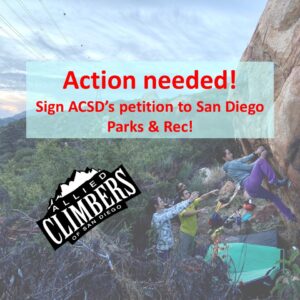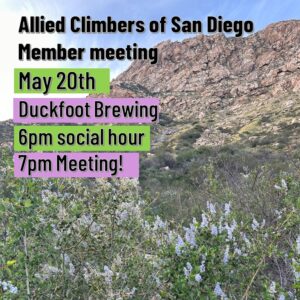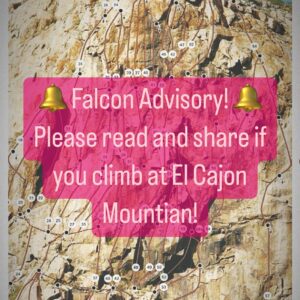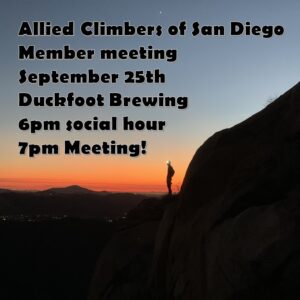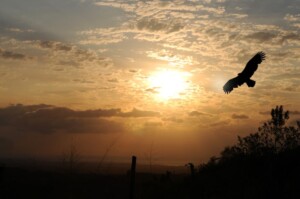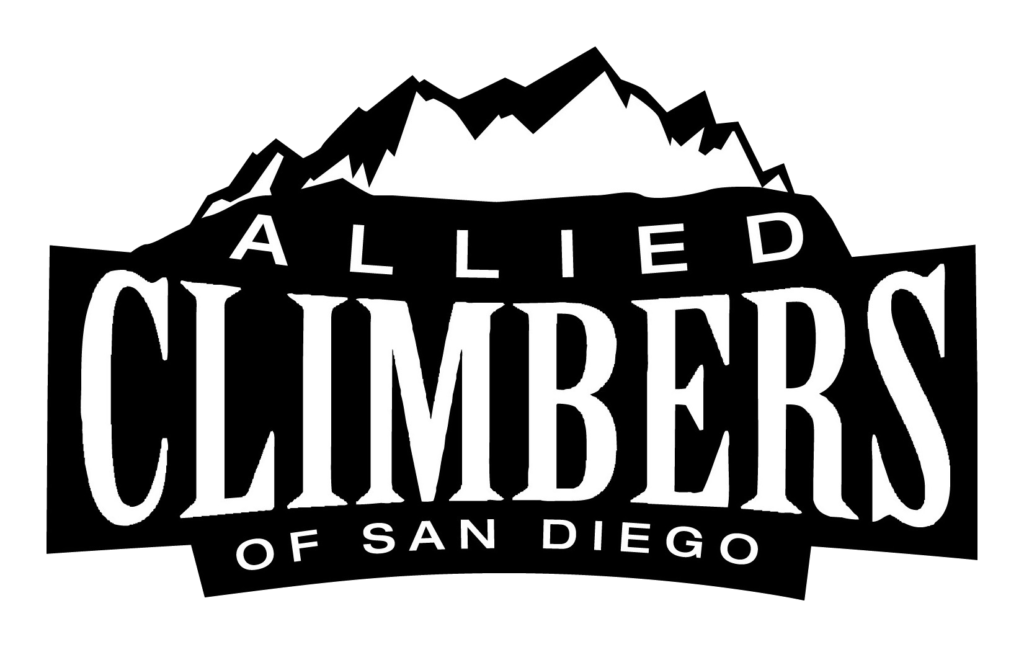
Important Update From Our President
Hello, my name is Josh Higgins, and I am the current CEO and President of the Allied Climbers of San Diego (ACSD). ACSD has been on a public hiatus for various reasons during the pandemic. It started with land managers not allowing events, and other COVID-related closures, and then we lost momentum for our public-facing work. Many on the board had kids, injuries, and other issues that kept us busy or off the rocks, and what little time we had was focused on access as opposed to education and cleanups. We did work on access issues behind the scenes for the last couple of years and started up our public meetings again this past July with the plan for our next meeting on September 19th.
During the beginning of the year, we had questions from the climbing community about the Cleveland National Forest (CNF) wording on their website regarding raptor management and seasonal closures. In the past, ACSD often worked with the CNF to have accurate information, and supply them with maps, or other details like what raptor is nesting where. Peregrine and prairie falcon nesting activity begins locally in February of each year, advisories are initiated on March 1st. But the CNF has moved these dates up at Eagle Peak and Corte Madera, initiating closures and advisories beginning December 15th, which coincides with golden eagle nesting. However, there are no golden eagles nesting on these resources. There are old historic nests on Eagle Peak and Corte Madera that are not active and have not been active for 30 to 50 years.
This range of closure dates at these resources would create at best a truly marginal climbing season on some of the best climbing resources in the county. Modern raptor management generally bases closure windows on monitored nest activity. Once a raptor is done with its nest the closure should be lifted, often this happens before July. This is also only done for the presence of active nests, not historical nests which are decades old.
Additionally, adding to the confusion is that the CNF website indicates El Cajon Mountain is closed for golden eagle nesting. But the GE nests are not on CNF lands and are nowhere near the El Cajon Mountain climbing area (AKA The Wedge). The GE nests are actually around the south buttress and are located on BLM lands which are managed by San Diego County Parks and Recreation and which are far removed from the viewshed of the climbing resources on El Cajon Mountain.
We assumed there was staff turnover, or some other issue, that resulted in a miscommunication of information, so we reached out to the CNF to clarify the closure information. Unfortunately, it took over two months and many attempts from both the Access Fund and myself to coordinate a meeting with the CNF. The meeting took place via Zoom on Friday, July 22, and included the Access Fund, ACSD, and the CNF.
Jeff Brown, Katie Goodwin from the Access Fund and I were on the call with Kirsten Winter, a biologist with the CNF. Importantly, Kirsten is the same biologist who was instrumental in enacting the closures of Eagle Peak and Corte Madera for historic golden eagle nests in 2006 which resulted in the formation of ACSD.
Our goal for the meeting was to clarify the closure language posted on the CNF website regarding El Cajon Mountain and offer the climbing communities assistance for future management of the area. Our long-term goal is to re-establish adaptive closure boundaries based on modern raptor management science, which includes line of sight buffers and closure dates based on nesting activity and monitoring data. This is what was agreed to when ACSD and the CNF mediated a compromise in the late 2000s. The mediation was overseen by the National Institute for Environmental Conflict Resolution as part of the National Environmental Policy Act (NEPA) process intended to avoid litigation.
The following link is to a 2015 CNF News Release identifying closures for golden eagles at Glen Cliff from December 15th to July 1st, and advisories for peregrine and prairie falcons at Corte Madera and Eagle Peak from March 1st to July 31st. As noted in the link, These actions are in coordination with other cooperating agencies including the California Department of Fish and Wildlife and the U.S. Fish and Wildlife Service.
https://www.fs.usda.gov/detail/cleveland/news-events/?cid=STELPRD3828855
This news release reflects the agreed-to restrictions and ACSD fully supports them and the stipulated time frames and durations as they are appropriate based on the specific species’ reproductive biology and recent nesting activity. However, the December 15th start date is not necessary and is not appropriate for rec-use areas which have historical golden eagle nests.
Important for the climbing community, and others, to understand is that we found ourselves at odds with the CNF in 2006 when they attempted to unilaterally institute the same type of restrictions as theyve done again at Corte Madera and Eagle Peak. The previous restrictions were in violation of the CNFs own Land Management Plans and were not based on sound science and common sense.
The CNF issued an Environmental Assessment to close access to our climbing resources for these very same historical golden eagle nests. We challenged the EA and followed the NEPA Administrative Appeal Process to its end, which resulted in the CNF/ACSD mediation. Before we engaged in mediation, however, the CNF refused to work collaboratively with us and ACSD actually had to file a Freedom of Information Act (FOIA) request to obtain information about the nesting activities at these resources. We were being told by the CNF that the nests were only recently vacated. What we discovered was that the CNFs own records documented no recorded golden eagle nesting at Corte Madera since 1978, and only speculative nesting at Eagle Peak prior to 1991. These records also provided no evidence that nesting actually occurred at Corte Madera and Eagle Peak on the cliff faces that climbers use.
During our recent Zoom call, CNF staff were speculative of our suggestions but agreed to review Access Funds Raptor Management Handbook. In subsequent email conversations, it appears at this time the CNF wants to continue to use one-mile buffers around all active and inactive golden eagle nests in the Forest.
ACSD has always tried to balance the environment with climbing access. We believe that the raptors should be given their space to breed and flourish, but that there are reasonable precautions that allow climbing as well. Published research looking at adaptive management of raptors and recreation suggests setting up line of site buffers that are established by conducting a viewshed analysis. These line of site buffers adequately protect nesting activity and eliminate any disturbance from human activity. This method generally allows for a smaller closure area while protecting raptors from disturbance. This strategy is used at many popular climbing destinations across the country including Zion National Park, Yosemite National Park and Rocky Mountain National Park.
The CNF was also not receptive during the call to the idea that buffers could be reduced at climbing areas on El Cajon Mountain, which are out of view of the nest. Kirsten Winter also stated that the December 15th start date for restrictions at Corte Madera and Eagle Peak were being done because there are GE nests at these locations. We noted that these nests are decades old. She replied that this was being doneeven for historical nestsunder the requirements of the Bald and Golden Eagle Protection Act (the BGEPA is silent on this point), and because she was waiting to hear back from the United States Fish and Wildlife Service about seasonal restrictions for [historical] golden eagle nests (no such USFWS requirement exists for historical nests). The golden eagle is not, nor has it ever been, listed as an endangered species. This fact is critically important. The USFS should not manage resources for species as though the species is endangered when it is not. The GE is also not listed as sensitive by the USFS within the CNFs own Land Management Plan.
Also of concern, the CNF noted that the creek we cross to access the El Cajon Mountain climbing areas is owned by the City of San Diegos water district and since climbers do not have explicit permission to cross, this land was considered closed to public use. This is in direct opposition to our understanding of access to public lands in the City of San Diego, as there are no closure signs and public property is open to public use unless posted otherwise. We will continue to work with CNF and the City of San Diego to clarify this matter.
During the call, I checked their website to cite their wording but they have taken it down, perhaps because we are out of the nesting season. We expect it to be the same in the fall at this point. Some have asked where to see the closures/advisories we are referring to, but they are not currently on their website, with the exception of the following link, which refers to the 2021-2022 nesting season.
https://www.fs.usda.gov/detail/cleveland/home/?cid=stelprdb5288499
We have plans to work on this, and the CNF said they would meet with us again in September to discuss these issues further. This will move slowly, and potentially be frustrating, but it is just how access issues are. We are advocating for you and our access and we will let you know if there are opportunities for the community at large to participate in the process.
What You Can Do To Help
In the meantime, people have asked what they can do. There is actually quite a lot!
1. We have a member meeting coming up on September 19th. We start hanging out around 6pm, and the official meeting starts around 7pm. Put it in your calendar, plan to attend, and spread the word. It is at an awesome location with a food truck off Miramar: Duckfoot Brewing – 8920 Kenamar Drive, Suite #210 San Diego, CA 92121. We plan to have a member meeting every other month going forward.
2. Follow us on social media, and tell your friends who would be interested. On Instagram we are officalacsd. On Facebook we are Allied Climbers of San Diego. If you are not on our email list, please make sure you sign up to get updates on this situation. If you are already on our list, pleases spread the word by getting others to join the list as well right here on our website. There is an obvious join/renew button on the top right, and you can either join ACSD, join as a joint ACSD and Access Fund member, or even for free as an “E-member” and you’ll be added to our email list. We strongly recommend joint membership since access fights are local, national and constant.
3. Share our posts and emails with others! Talk to your friends about access issues or our events! It is hard for us to get the word out to the entire community and your help is appreciated.
4. Help out and join the board! If you have questions, come to a meeting or reach out. We must have new blood on the ACSD board in the near future or access will eventually be negatively impacted. Some of us have been doing this for over 15 years, and don’t even climb anymore. I’m currently the CEO and President, and at the last meeting, I was Secretary as well after losing another board member. I can’t do it all. You will learn, build your resume, knowledge, and skills, and have an impact on the world in a wonderful way. If you are good with event planning, want to be our treasurer or secretary, enjoy public speaking, or just want to learn how to organize one cleanup a year we’d love to have you.
Thank you for your support,
Josh Higgins
CEO/President of the Allied Climbers of San Diego
[/fusion_text][/fusion_builder_column][/fusion_builder_row][/fusion_builder_container]
